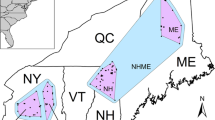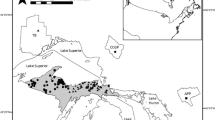Abstract
Climate change is likely to alter population connectivity, particularly for species associated with higher elevation environments. The goal of this study is to predict the potential effects of future climate change on population connectivity and genetic diversity of American marten populations across a 30.2 million hectare region of the in the US northern Rocky Mountains. We use a landscape resistance model validated from empirical landscape genetics modeling to predict the current and expected future extent and fragmentation of American marten dispersal habitat under five climate change scenarios, corresponding to climatic warming of between 0.7 and 3.3 °C, consistent with expected climate change by year 2080. We predict the regions of the current and future landscapes where gene flow is expected to be governed by isolation by distance and the regions where population fragmentation is expected to limit gene flow. Finally, we predict changes in the strength and location of predicted movement corridors, fracture zones and the location of dispersal barriers across the study area in each scenario. We found that under the current climate, gene flow is predicted to be limited primarily by distance (isolation), and landscape structure does not significantly limit gene flow, resulting in very high genetic diversity over most of the study area. Projected climatic warming substantially reduces the extent and increases the fragmentation of marten populations in the western and northwestern parts of the study area. In contrast, climate change is not predicted to fragment the extensive higher elevation mountain massifs in central Idaho, the northern U.S. continental divide, and Greater Yellowstone Ecosystem. In addition, we show locations in the study area that are important corridors in the current landscape that remain intact across the climate change scenarios.







Similar content being viewed by others
References
Brook BW, Tonkyn DW, Q’Grady JJ, Frankham R (2002) Contribution of inbreeding to extinction risk in threatened species. Conserv Ecol 6(1):16
Broquet T, Johnson CA, Petit E, Thompson I, Burel F, Fryxell JM (2006) Dispersal and genetic structure in the American marten, Martes americana. Mol Ecol 15:1689–1697
Brown JH, Kodric-Brown A (1977) Turnover rates in insular biogeography: effect of immigration on extinction. Ecology 58:445–449
Bull EL, Heater W (2001) Home range and dispersal of the American marten in northeastern Oregon. Northwest Nat 82:7–11
Compton B, McGarigal K, Cushman SA, Gamble L (2007) A resistant kernel model of connectivity for vernal pool breeding amphibians. Conserv Biol 21:788–799
Crnokrak P, Roff DA (1999) Inbreeding depression in the wild. Heredity 83:260–270
Cushman SA, Landguth EL (2010) Spurious correlations and inference in landscape genetics. Mol Ecol 19:3592–3602
Cushman SA, Schwartz MK, Hayden J, McKelvey KS (2006) Gene flow in complex landscapes: testing multiple hypotheses with causal modeling. Am Nat 168:486–499
Cushman SA, McKelvey K, Schwartz MK (2009) Using empirically derived source-destination models to map regional conservation corridors. Conserv Biol 23:368–376
Cushman SA, Chase MJ, Griffin C (2010a) Mapping landscape resistance to identify corridors and barriers for elephant movement in southern Africa. In: Cushman SA, Huettman F (eds) Spatial complexity, informatics and wildlife conservation. Springer, Tokyo, pp 349–368
Cushman SA, Compton BW, McGarigal K (2010b) Habitat fragmentation effects depend on complex interactions between population size and dispersal ability: modeling influences of roads, agriculture and residential development across a range of life-history characteristics. In: Cushman SA, Huettman F (eds) Spatial complexity, informatics and wildlife conservation. Springer, Tokyo, pp 369–387
Cushman SA, Landguth EL, Shirk AJ (2012) Separating the effects of habitat area, fragmentation and matrix resistance on genetic differentiation in complex landscapes. Landsc Ecol 27:369–380
Cushman SA, Shirk A, Landguth EL (Submitted) Landscape genetics and limiting factors. Conservation Genetics
Davis MB, Shaw RG (2001) Range shifts and adaptive responses to Quaternary climate change. Science 292:673–679
Dennis B (2002) Allee effects in stochastic populations. Oikos 96(3):389–401
Elsner MM, Cuo L, Voisin N, Deems J, Hamlet AF, Vano JA, Mickelson KEB, Lee SY, Lettenmaier DP (2010) Implications of 21st century climate change for the hydrology of Washington State. Clim Chang 102(1–2):225–260. doi:10.1007/s10584-010-9855-0
ESRI (2007) ARCGIS. Environmental Systems Research Incorporated, Redlands
Fahrig L, Pedlar JH, Pope SE, Taylor PD, Wegner JF (1995) Effect of road traffic on amphibian density. Biol Conserv 73:177–182
Gibbs JP (1998) Amphibian movements in response to forest edges, roads, and streambeds in southern New England. J Wildl Manag 62:584–589
Harrison S (1991) Local extinction in a metapopulation context: an empirical evaluation. Biol J Linn Soc 42:73–88
Hedrick PW, Kalinowski ST (2000) Inbreeding depression in conservation biology. Annu Rev Ecol Syst 31:139–162
IPCC (2007) Climate change 2007: the physical science basis. In: Solomon S, Qin D, Manning M, Chen Z, Marquis M, Averyt KB, Tignor M, Miller HL (eds) Contribution of working group I to the fourth assessment report of the Intergovernmental Panel on Climate Change. Cambridge University Press, Cambridge
Iverson LR, Prasad A, Schwartz MW (1999) Modeling potential future individual tree-species distributions in the eastern United States under a climate change scenario: a case study with Pinus virginiana. Ecol Model 115:77–93
Koen EL, Bowman J, Garroway CJ, Mills SC, Wilson PJ (2012) Landscape resistance and American marten gene flow. Landsc Ecol 27:29–43
Landguth EL, Cushman SA (2010) CDPOP: an individual-based, cost-distance spatial population genetics model. Mol Ecol Resour 10:156–161
Landguth EL, Hand BK, Glassy J, Cushman SA (2012) UNICOR: a species connectivity and corridor network simulator. Ecography 35:9–14
Littell JS, Elsner MM, Mauger G, Lutz E, Hamlet AF, Salathé E (2011) Regional climate and hydrologic change in the northern US Rockies and Pacific Northwest: internally consistent projections of future climate for resource management. Final report http://cses.washington.edu/picea/USFS/pub/Littell_etal_2010/Littell_etal._2011_Regional_Climatic_And_Hydrologic_Change_USFS_USFWS_JVA_07Jan11.pdf
Maxwell J, Gergely K, Aycrigg J (2011) Gap analysis bulletin no. 18. USGS/BRD/Gap Analysis Program, Moscow, ID
McGarigal K, Cushman SA, Neel MC, Ene E (2002) FRAGSTATS: Spatial Pattern Analysis Program for categorical maps. Computer software program produced by the authors at the University of Massachusetts, Amherst. www.umass.edu/landeco/research/fragstats/fragstats.html
McKelvey KS, Copeland JP, Schwartz MK, Littell JS, Aubry KB, Squires JR, Parks SA, Elsner MM, Mauger GS (2011) Climate change predicted to shift wolverine distributions, connectivity, and dispersal corridors. Ecol Appl 21:2882–2897
McKenzie D, Peterson DW, Peterson DL, Thornton PE (2003) Climatic and biophysical controls on conifer species distributions in mountain forests of Washington State, USA. J Biogeogr 30:1093–1108
Minder JR, Mote PW, Lundquist JD (2010) Surface temperature lapse rates over complex terrain: lessons from the Cascade Mountains. J Geophys Res 115:D14122. doi:10.1029/2009JD013493
Mote PW, Salathé EP (2010) Future climate in the Pacific Northwest. Clim Chang 102(1–2):29–50
O’Grady JJ, Brook BW, Reed DH, Ballou JD, Tonkyn DW, Frankham R (2006) Realistic levels of inbreeding depression strongly affect extinction risk in wild populations. Biol Conserv 133(1):42–51
Opdam P, Wascher D (2004) Climate change meets habitat fragmentation: linking landscape and biogeographical scale levels in research and conservation. Biol Conserv 117:285–297
Parmesan C, Yohe G (2003) A globally coherent fingerprint of climate change impacts across natural systems. Nature 421:37–42
Reh W, Seitz A (1990) The influence of land use on the genetic structure of populations of the common frog Rana temporaria. Biol Conserv 54:239–249
Rehfeldt GE, Crookston NL, Warwell MV, Evans JS (2006) Empirical analysis of plant–climate relationships for the western United States. Int J Plant Sci 167:1123–1150
Schwartz MK, Copeland JP, Anderson NJ, Squires JR, Inman RM, McKelvey KS, Pilgrim KL, Waits LP, Cushman SA (2009) Wolverine gene flow across a narrow climatic niche. Ecology 90:3222–3232
Semlitsch RD, Bodie JR (1998) Are small, isolated wetlands expendable? Conserv Biol 12:1129–1133
Shirk AJ, Cushman SA (2011) sGD software for estimating spatially explicit indices of genetic diversity. Mol Ecol Resour 11:922–934
Short Bull RA, Cushman SA, Mace R, Chilton T, Kendall KC, Landguth EL, Schwartz MK, McKelvey KS, Allendorf FW, Luikart G (2011) Why replication is important in landscape genetics: American black bear in the Rocky Mountains. Mol Ecol 20:1092–1107
Stacey PB, Taper M (1992) Environmental variation and the persistence of small populations. Ecol Appl 2:18–29
Tanaka Y (2000) Extinction of populations by inbreeding depression under stochastic environments. Popul Ecol 42(1):55–62
Thomas CD, Cameron A, Green RE, Bakkenes M, Beaumont LJ, Collingham YC, Erasmus BRN, Ferreira de Siqueria M, Grainger A, Hannah L, Hughes L, Huntley B, van Jaarsveld AS, Midgley GF, Miles L, Ortegoa-Huerta MA, Townsend Peterson A, Philips OL, Williams SE (2004) Extinction risk from climate change. Nature 427:145–148
Wasserman TN, Cushman SA, Wallin DO (2010) Spatial scaling and multi-model inference in landscape genetics: Martes americana in northern Idaho. Landsc Ecol 25:1601–1612
Wasserman TN, Cushman SA, Shirk AS, Landguth EL, Littell JS (2012) Simulating the effects of climate change on population connectivity of American marten (Mates americana) in the northern Rocky Mountains, USA. Landsc Ecol 27:211–225
Wasserman, TN, Cushman SA, Wallin DO, Hayden J (in press) Multi scale habitat relationships of Martes americana in northern Idaho, U.S.A. USDA Forest Service RP
Willi Y, Van Buskirk J, Hoffmann AA (2006) Limits to the adaptive potential of small populations. Annu Rev Ecol Evol Syst 37:433–458
Wilson PJ, Provan J (2003) Effect of habitat fragmentation on levels and patterns of genetic diversity in natural populations of the peat moss Polytrichum commune. Proc Biol Sci 270:881–886
Author information
Authors and Affiliations
Corresponding author
Rights and permissions
About this article
Cite this article
Wasserman, T.N., Cushman, S.A., Littell, J.S. et al. Population connectivity and genetic diversity of American marten (Martes americana) in the United States northern Rocky Mountains in a climate change context. Conserv Genet 14, 529–541 (2013). https://doi.org/10.1007/s10592-012-0336-z
Received:
Accepted:
Published:
Issue Date:
DOI: https://doi.org/10.1007/s10592-012-0336-z




